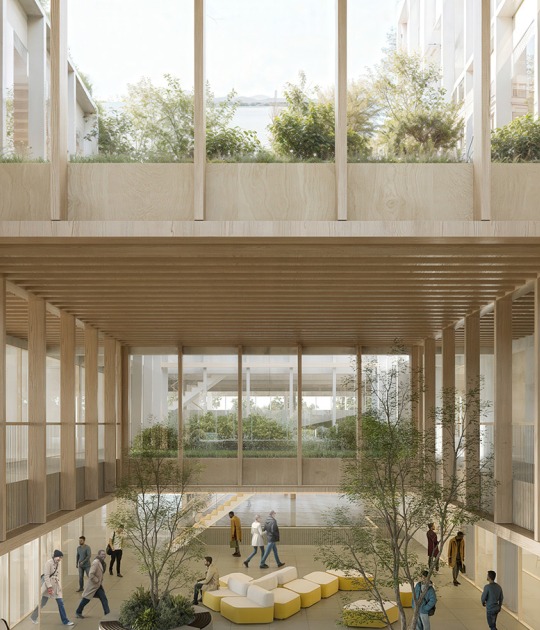The Architecture of Everyday Death
Elevators deliver transfer cases and traditional caskets to rooms in a hotel-like block reserved for funeral services. Bodies intended for value extraction continue in refrigerated cases, on delivery Sentinels, to the Necro-Prairie. The neighborhood’s plan of cul-de-sacs not only adopts the existing suburban typology of the adjacent base housing but also conforms to the centripetal distribution of the Sentinel.
In the Necro-Prairie, families of the dead elect to have their loved ones processed within the domestic realm. Like Leonidov’s linear city, housing is concentrated in a central core, in symbiosis with attendant recreational, political, and virtual programs at its edge. Here the symbiosis is twofold. On the one hand, energy, heat, and fluids produced by body processing and Beach Body home gyms are captured toward the sustenance and reproduction of the overall urbanism. The second symbiotic valence is the neighborhood’s provision of architectures for virtual social engagement of the expanded Dover public. Internet Legion Veterans’ Clubs are a real and digital platform for those registered with Dover’s Memorial social media pages. It is a site to access the digital archives of dead service members and to extend the lifespan of that material. Beach Body Barracks offers a kind of active fitness grief therapy: a common response to those confronted with the specter of death. Also, a cohort of mobile news media vehicles sets up an encampment to film dignified transfers for a transnational audience. The Necro-Prairie sponsors constant exchange between virtual and real, living and dead bodies.
Necro-Prairie houses are designed to accommodate Cremation, Alkaline Hydrolysis (or liquid cremation), and Human Mineral Extraction. The infrastructure that connects each house extends underground across Dover’s fields and surfaces across the runway to allow trailer homes to plug into the grid. These trailers house returning Dover families, Beach Body recruits participating in boot camp programs, and family members who can’t be accommodated in the Necro-Prairie houses. From a window, trailer residents have a visceral experience every time a Lockheed Martin C5 Super Galaxy Transport Jet lands or take off.
Not everybody processed by Dover’s arsenal is processed at the Base. The Sentinel is a critical actor at Dover and extends the reach of its urbanism beyond its own borders. It stewards bodies between urbanisms; it hosts ceremonial events on its platforms; and, hovering over your backyard, it can chemically dissolve dead bodies through alkaline hydrolysis in states where the practice is not yet legal.
Those who choose alkaline hydrolysis for processing in the afterlife will be transformed into a fertile solution that is then used to sow a field of flowers of your choosing. Dover’s own Digital Elysium is the site of the Sentinel’s printing of the landscape with the flowers of the dead. Here, server gravestones securely store the digital material of the fallen. When revisiting the site, family members are sent random fragments to their mobile devices which recognize, through the Dover Profile App, the site of their loved one’s fertilization. Thus, past relationships are revived through a virtual, random access interface on the last site of your loved one’s material existence.
Dover also travels, so to speak, through the availability of the Necro-Prairie housing catalog for productive domestic urbanism, as observed at the twin development for Camp David II. Its mobile technologies also deploy to the theater of war and produce new arrangements of power bars for military engagement, as witnessed in the remote compact deployment plans for Donetsk, Ukraine, and Al Taqaddum II, in Iraq.
* "The Architecture of Everyday Death" is the thesis project presented by Igor Bragado and Miles Gertler at the School of Architecture of Princeton University that began with the work "The Transurban State of Death" realized for Andrés Jaque's class.
































